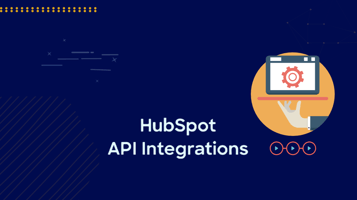Table of contents
As sales and marketing operations and technologies continue to evolve, financial services firms are constantly finding new ways to integrate marketing, sales, and customer service into a functional and streamlined business strategy. Sales Operations (SalesOps) and Revenue Operations (RevOps) are common approaches used to manage marketing and sales operations. Both strategies require the use of targeted technology to support operations, gather and sort data, and enhance customer satisfaction. In the context of HubSpot vs. Salesforce, HubSpot integrations are one such way to accomplish this. Let's examine how they measure up against Salesforce.
As the first cloud-based CRM system, Salesforce focuses on customer relationships, with applications to assist with marketing, analytics, customer service, and development. Although Salesforce offers benefits for SalesOps, RevOps are rapidly overtaking Sales Operations as a more streamlined business management strategy. The wider net cast by RevOps requires a more flexible and versatile system, and HubSpot integrated platform has stepped in to fill that gap. In this article, we will discuss the differences between HubSpot and Salesforce, and explain which offers the most benefits when it comes to your RevOps strategies.
HubSpot vs. Salesforce:
Revenue vs. Sales Operations
When comparing HubSpot vs. Salesforce, Sales Operations and Revenue Operations may seem similar at first glance, but each set of operations has a different focus and technique. In order to choose the right software for your operations, it is important to understand the major differences between SalesOps and RevOps.
Sales Operations
SalesOps helps to streamline the sales process using Customer Relationship Management (CRM) software, cloud-based phone systems, and interactive sales platforms. The goal of SalesOps is to facilitate smooth, efficient workflow for sales teams in order to achieve optimal business growth. SalesOps is the support system for the sales team of many companies. They must often work across functions within the organization to enable sales strategies, organize sales data, provide sales forecasting reports, and manage team performance. Depending on your organization's needs, they may also help to organize and train your sales team.
Revenue Operations
Revenue Operations, or RevOps, focuses on the entire customer lifecycle, from marketing and sales to customer success, customer insights, and process improvement. Unlike SalesOps, which focuses solely on the sales team, RevOps strategies use an all-encompassing approach. These strategies boost revenue growth by eliminating process and data silos between departments and encouraging business unit cooperation.
RevOps is largely responsible for managing operations related to revenue, including sales, marketing, and customer service. This includes developing business objectives and establishing strategic operations to manage each department independently and the organization as a whole. To facilitate smooth interaction between internal business units, RevOps also works to remove interdepartmental obstacles and enhance organization-wide communication.
Using advanced technology, RevOps manages, coordinates, and obtains data regarding sales, marketing, and customer service. With data obtained through these systems, RevOps analyzes both long and short-term trends. It not only enables and synchronizes sales and marketing strategies but does so by ensuring the optimal customer experience. By managing all the operations from one place, you can create a more effective organization. All teams work together seamlessly to create a flawless customer experience.
HubSpot vs. Salesforce Integrations
Salesforce and HubSpot are both useful CRM tools. They each have unique operating features that can significantly affect your financial services RevOps strategy.
Salesforce
As the first cloud-based CRM, Salesforce was originally established in 1999 with the goal of creating sales force automation. It was developed primarily for internal use and did not have an external, client-facing platform. For the time, Salesforce software was revolutionary. It has since led to an entire industry centered around Software as a Service (SaaS) business. In many ways, Salesforce remains a powerful player in the SaaS market. However, it is becoming less compatible with more sophisticated RevOps methods.
HubSpot Integrations
For businesses that are increasingly turning to RevOps, HubSpot can serve as a more comprehensive platform for integrating various applications. While Salesforce users rely on different programs for sales acceleration, customer service, and marketing automation, HubSpot has hundreds of applications that allow you to build a fully functional suite tailored to your company's particular needs with a centralized database.
HubSpot's design integrates all internal teams. It encompasses both internal and customer-facing elements. These include an integrated CMS, interactive forms, and marketing campaigns through social media integration and email automation. Using HubSpot's Operations Hub, you can keep all of your data clean and up to date. Use automated processes that allow all of your business units to access the same information at all times.
Why HubSpot is Better for RevOps
Hubspot and Salesforce integrations can be challenging, regardless of your operational needs. The trick lies in finding a CRM platform that meets all your requirements. When you're working from a RevOps perspective, that means integrating more than just sales and marketing. While cost may be a factor, most companies are interested in functionality. As companies incorporate RevOps into their operational strategy, HubSpot has become the way to seamlessly integrate every aspect of their go-to-market strategy smoothly and quickly.
Salesforce can attribute its growth to the acquisition and integration of other firms onto their platform. Unfortunately, this makes it difficult to provide centralized data for each team. HubSpot was created to overcome this problem. It centralizes all customer data as the single source of truth with a focus on overall customer experience. This allows applications and workflows to be built based on this centralized data.
When users attempt to integrate Salesforce into their wider operations, they run into two primary problems. First, they use it as a standalone product. This prevents it from working dynamically throughout the entire customer lifecycle workflow. Other systems are incorporated to fill the gaps, so data integrity and consistency in Salesforce can quickly become sporadic and outdated.
Secondly, Salesforce lacks flexibility, particularly when used as the primary system of record. In order to optimize system functionality, companies must incorporate other applications to accelerate and enable sales. The result is bloated tech stacks that are expensive and inefficient.
HubSpot integrations, on the other hand, provide users with a fully integrated platform and a variety of applications. That allows you to customize your customer's experience and streamline operations across every business unit. RevOps strategies are more successful with better inter-departmental communication, real-time data synchronization, and a user-friendly interface.
Choosing a Partner for Your RevOps Needs
At Learners.ai, we are committed to helping you optimize your operations through seamless RevOps integrations. Get started with the RevOps Checklist to evaluate where you are on the RevOps Maturity Curve to start your RevOps journey. To find out how Learners.ai can revolutionize your business, book a consultation with our RevOps experts today.



